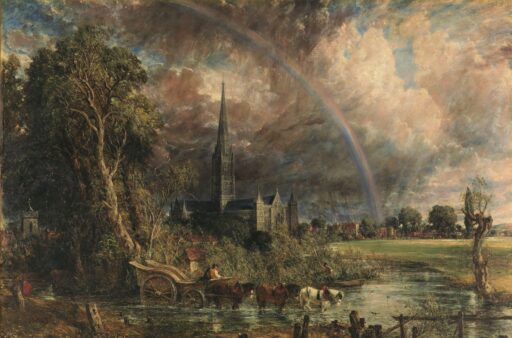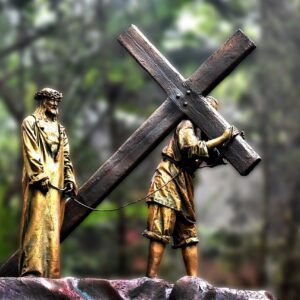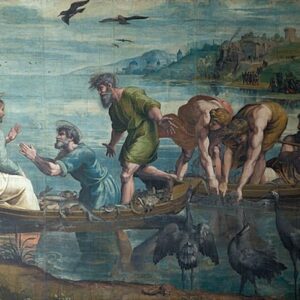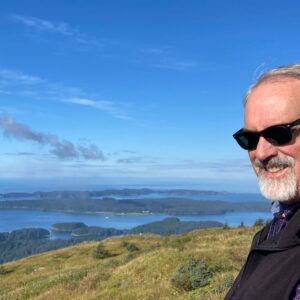This post comprises a series of anecdotes about churches and church going which, with luck and daring, I might manage to coalesce by the end.
For Anecdote No.1, I turn to the English philosopher and Anglican-priest-turned-hippie Alan Watts, known for popularizing Eastern thought and religion from the 1950s until his untimely death in 1973. Somewhere—I believe in his autobiography—Watts confesses that while he can sometimes feel like a Christian inside a beautiful church, the moment he steps outside the church and is in the open air, he loses that feeling. Christianity is something kept in imposing artificial beauty, not found in the wild.
Anecdote No.2 comes from J.R.R. Tolkien, though I doubt the speculation is original to him. Somewhere (I’m very sorry but it’s summertime and the livin’s easy, meaning that I am not in a mood to look things up) the master fantasist and scholar wonders if the Gothic cathedrals were perhaps memories molded in stone of the great Hercynian Forest that the Celtic and Germanic peoples inhabited before it was felled to build the civilization of the High Middle Ages.
Anecdote No.3 concerns the pandemic. There was a Catholic parish near me that moved Mass outside for a while. A nearby Catholic school did the same. I remember my profound disappointment when they eventually went back indoors. I thought, then, and still think, that we have more churches than we need in this country, and nowhere near enough sacred groves.
Anecdote No.4 comes to you from Aachen, Germany, specifically its cathedral, called the Karlsdom because it was built by Charlemagne, who is buried there. This is the first European cathedral I entered and experienced as a living and sacred place in my irreligious adolescence, the summer I was thirteen, living with my family in Maastricht, Netherlands (which also has an amazing and even more ancient cathedral). We would cycle to Aachen, and there was something about the Karlsdom, and the Emperor associated with it, which awed my imagination. If you stand in the middle of the part Charlemagne built and look up, you see this:
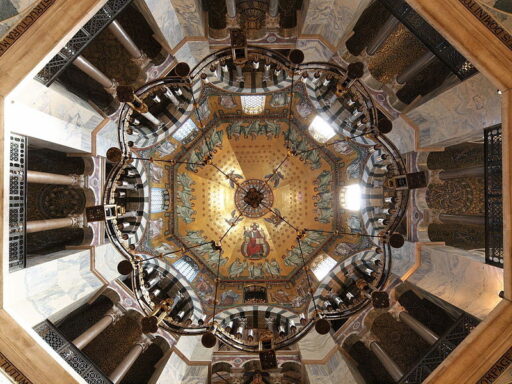
Anecdote No.5 concerns a place of much more recent personal discovery for me: the Gallarus Oratory on the Dingle peninsula in County Kerry, Ireland. It is little more than a hut, though its fashioning is intricate. To turn the unhewn stones of a place into such a shelter (that is what some think it was: a shelter for pilgrims) is to me profound art. I stopped in there once with my wife. We were not pilgrims exactly, but we did need to pray, and this overturned boat—so it looks to many—with its empty interior chiaroscuro, waiting womblike to be filled, somehow seemed the right place for that prayer.
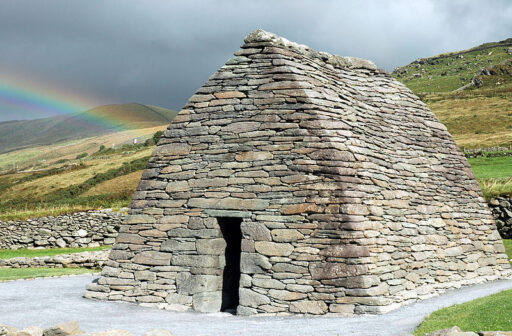
Anecdote No.6 I take from the world of memes. Perhaps you have seen this lately: an image of a Gothic cathedral—the kind Tolkien supposed substituted for primeval forest, and the kind of building Alan Watts was wary of precisely because the Christian feeling seemed yoked to its aesthetic might—an image of, say, Chartres or Winchester, within or without, juxtaposed with that of some massive and monstrous modern building. Why can’t we build this anymore? Why do we build skyscrapers—temples of high finance—instead? the meme asks. It’s never something like the Gallarus Oratory pleading from the former times.
And it’s never something like my seventh and final anecdote, the Stavkirke (“church of staves” referring to the method of construction) on Washington Island, Wisconsin:
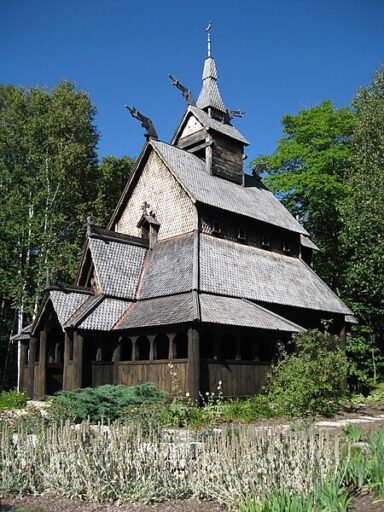
With my family I visited Washington Island for the first time last summer. I was in an intellectual quandary, deeply frustrated. Then I came to the Stavkirke, and something happened, or I felt something similar to what I had known at the Gallarus Oratory, but stronger, perhaps because the landscape was less foreign. You see, I am always troubled by two things which are really one thing. One thing, or one part of this big thing, is religion: Why does it seem so broken now, so impossible? And the other part is the ecological crisis: How can my work as a writer, teacher, or father answer to these uncanny times? But when I visited the Stavkirke I felt calm for the first time in what seemed years, and I’ve managed to carry some of that calm with me since.
But something else has happened, too. Thanks to some strange insight that visited me in that church of staves, built in imitation of a church in Norway that dates from the time of the cathedrals, I have gradually come to realize that what I am questing after in all my work is what I think of as the future religion. By this phrase I don’t mean that I expect the Christian faith (or any other) to collapse at some point in the near future. But I think that all religion, if it will survive this century, will have to shed present institutional trappings and many intellectual traditions in order to guide us to a reimagination of the bond between humankind and the Earth. For we have grown estranged from the Earth, even from our own bodies.
In fact—and this is nothing that we don’t all know, if we would but admit it—we have forgotten that the world is given, that before God forgives and saves, he creates, loves, and indwells his world, of which we are part and from which our destiny is inextricable. We have lost the feeling of being creatures. But at the Stavkirke, for a moment, I had that feeling back, as I think I had it back for a moment at Gallarus some years before.
It has to do with form and material. I keep going back to Watts’s suspicion of the overwhelming churchly aesthetic (something I first glimpsed in Aachen), and to Tolkien’s idea of the great cathedrals as ersatz forest. I remember how right it felt to celebrate Mass outdoors during the pandemic, as if some unnatural awkwardness or pressure had been lifted. It took a lot of time to build the Stavkirke, and effort and skill. But I think that if the Christian Church survives, it will be in churches like that one on Washington Island. As Philip Larkin wrote: “a serious house on serious earth it is.” I cannot say why I feel this way, nor can I deny being moved by the splendid edifices and ruins of medieval European Christianity. I know many people have been converted by that beauty: long may it stand.
But I think it will not come again. There is a part of me that wonders if those monuments of spiring fluid stone did not after all prove to be the precursors of our skyscrapers—and that is why we build the skyscrapers now and not cathedrals to rival those of the thirteenth century. But the Stavkirke? It seems to come organically out of, and to be of the same nature as, its place. It is topotrophic, nursed by place. The Stavkirke and its ilk—or so it seemed to me on that remote island, in a troubled season—could be successor to the sacred groves, not their replacement.
Jonathan Geltner lives in Ann Arbor MI with his wife and two sons. His translation of Paul Claudel’s Five Great Odes is available from Angelico Press and a novel, Absolute Music, is available from Slant. If you enjoy his posts at Close Reading, check out his new Substack, Romance and Apocalypse, for more frequent and in-depth essays on the places where literature and other arts meet religious ideas and experience.

